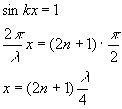| Ch. 17 | 33 | 34 | 35 | 37 | |||
| Ch.18 | 1 | 5 | 11 | 13 | sp1 | 21 | 41 |
This is updated !!! Numbers are from 5th Edition.. |
|||||||
| More Helpers | |||||||
| 11.
First things first. Calculate the wavelength: Next, recall the condition that the phase difference results from the path difference between the two waves in traveling from the speakers to the listener:
|
|||||||
| 13. At t = 0, we get the maximum displacement. Thus, |
|||||||
| sp1.
The standing wave for a string is : (0.30 m) sin(0.25x) cos(6.28t) where x is in meters and t is in seconds.. Find the wavelength and frequency of the interfering opposite traveling waves making up the total standing wave pattern.... |
|||||||
| sp1
hint. Compare the given expression with: Note: |
|||||||
21. Find the first 4 values of
the frequency. |
|||||||
41.
See fig. 18.13. page 512, ex. 18.7. For a pipe open at one end, we
have the following relationships: As noted in section 18.5, for a pipe open at one end, only odd harmonics are present: n = 1,3,5,… In this problem, as in example 18.7, the wavelength is constant. Thus we achieve resonant modes by varying the length L of the air column. First, you must calculate the wavelength: Then you must use: and calculate the first two values of L that correspond to resonances. Note: These two values must be larger than 0.20 m, the minimum length of the air column. |
|||||||


